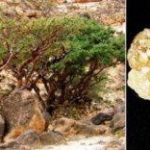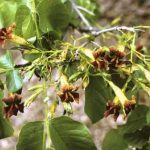TREE LIFE
February 1997
Members who have been to RIFA at Chirundu will wholeheartedly applaud the recent Cresta Conservation award to Leslee Maasdorp. Congratulations Leslee from all the members of the Tree Society, and we thank you for making our trips to the valley so enjoyable and interesting.
MASHONALAND CALENDAR
Saturday 15th February: The Botanic Garden walk this month is being moved to Saturday morning at 10.45 for 11 a.m. This is because Tom and some of our members will be attending the International AETFAT Conference being held in Harare during the first part of this month.
So, on Saturday we will meet Tom in the car park and continue with the fascinating topic of creepers. This will be Part 2 as last month’s walk was rained-out. There will be a guard for the cars.
Sunday 16th February: We will be meeting Rob Croukamp in the Great Dyke area where he will show us some interesting places with diverse vegetation.
Saturday 22nd February: Mark’s Botanic Walk will take place at another of our favourite spots. The venue is the south-western area of the Mukuvisi Woodland in the public walking area. Access is through the gate at the corner of Paget road and Inyanga Crescent. We will meet here at 2.30 p.m. There will be a guard for the cars.
Tuesday 4th March: Botanic Garden Walk. Sunday 16th March. To an interesting area on the Shavanhohwe River along the Mutoko Rd.
Saturday 22nd March: Mark’s Botanic Walk.
Thursday 27 to Monday 31 March – Easter: We have been lucky to reserve the Wildlife Society Camp at Tuli Circle for Easter.
Accommodation is either in your own tent or in ladies’ or gents’ dorms which are equipped with beds and foam rubber mattresses. All food, liquid refreshments including water must be brought, as well as bed linen etc. Cooking utensils are provided. There is no electricity at the camp but lamps are provided as well as a gas fridge and stove. The cost has not yet been finalised but is expected to be in the region of $30 per night per adult and slightly less for children under 12. Members of the Wildlife Society may also pay a little less.
If you are interested in spending Easter in Tuli please telephone Maureen Silva-Jones at home.
MATABELELAND CALENDAR
Sunday 2nd February: A visit to Chris and Dick Stevens. Meet at Girls’ College car park for a prompt 8.30 departure.
Monday 10th February – Study Session.
Urban trails in Circular Drive area. Meeting at 5-5.15 p.m. These sessions will take place on the second Monday of every month.
Some time ago a subcommittee of the Tree Society was formed to assist with tree planting projects. This Subcommittee became involved with the Association of the Greystone Nature Preserve and a great deal of progress has been made. A booklet has been published about the preserve containing descriptions of trees and birds which are to be found there as well as other interesting facts. The booklet may be obtained ($30) from the Hon. Warden – Mr. Dave Christlieb.
TREE DAY TO GOMBERA RANCH. 17 NOVEMBER 1996
The visit to a stream, trickling still this dry spring season from the Hunyani Hills towards the river, was a day of special treats. To walk in cool shaded gallery vegetation after the searing heat of the past few weeks was such a joy, that for once we all really just took pleasure in the great trees – Keats and Rupert Brooke sprang to mind – “A thing of beauty is a joy for ever… Trees old and young, sprouting a shady boon …” Somehow serious study seemed to be out of keeping with the nature of the place, and when we got lost in the key, arriving at some really weird answers to some puzzles, it seemed easiest to just enjoy being there. Yes, Phil suggested that we were looking under the wrong section, and going through the Kariba and Mana areas section, later on, did lead to more probable answers, but I await Maureen’s findings on those puzzles.
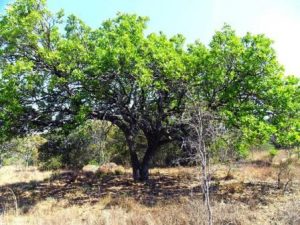
Syzygium guineense. Photo: Bill Clarke. Source: Flora of Zimbabwe
We parked in deep shade of very large Syzygium guineense – they did have petioles, if only 3-4mm long – and large Erythrina abyssinica lacking seedpods or flowers. Nearby Rauvolfia caffra held shiny leaves high above, and thickets of Citrus limon – Lemon, Psidium guajava – Guava – and Morus alba – Mulberry, showed us what birds, monkeys and baboons do for plant dispersal once man’s presence is less felt. We heard the Purple-crested Lourie calling “Hok-hok-hok, pukpukpuk” intermittently, whilst Trumpeter Hornbills flew by crying nasally, a baby-like mewing rather than trumpeting; and the dog and small boy met up with a baboon that barked a warning and retreated.
But there were other fruiting trees nearby – Ficus sur, with leaves strangely large and rounded, Englerophytum magalismontanum at the stream’s edge, both reared up towards the sun high above our head; and it was Virginia’s orchid-hunting trained eyes that spotted the ripening fruit way beyond our reach. Celtis africana warned of the size they can achieve, given favourable conditions – beware of planting then in a small gardens. These were giants with smooth, lighter grey, straight boles, in green fruit; and one of the first we met had green, netted leaves to show that it is a major host plant for butterfly larvae, and so a double food source for birds. Ilex mitis also grew with its feet in the stream, another riverine species with smooth bark, that bears bird-enticing fruit – not seen that day alas. As a search amongst its light blotchy-green leaves did produce some showing the few sharp teeth along the margins, not enough to deter browsers – probably kudu from the height of the breakage’s –nearly all the Ilex along with the mulberries had branches damaged in the same way. Nearby, the River Combretum, Combretum erythrophyllum in fresh green leaf seemed to have escaped attention of both browsers and butterflies. Carissa edulis, the simple-spined Num-num, grew in profusion, starred with pink-backed, white, fragrant flowers, and studded with green to nearly ripe fruit. In one place it was inter-twined with the scrambler Pterolobium stellatum, making an impenetrable thicket, safe cover for nesting or shy birds like the Heuglin’s Robin and the Tchagra we had seen sneaking out of our way, and we thought of Brer Rabbit’s plea to Brer Fox. Further on we did meet up with a tree-sized Carissa, but mostly we saw why Dick Petheram would recommend it as an excellent anti-intruder device.
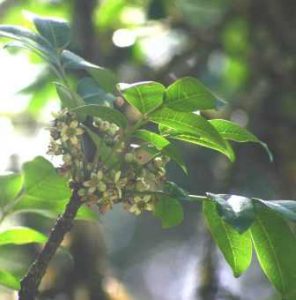
Ekebergia capensis. Photo: Bart Wursen. Source: Flora of Zimbabwe
Beyond the tangles, Ekebergia capensis, in green fruit drew our attention, when ripe the fruit look like pink-red cherries, food for birds and especially squirrels – but for us the odd smell verges on unpleasant. The seed germinates well if sown very fresh, with all the soft flesh washed off. Before we turned towards the real wonder of the place, a Ziziphus mucronata browse damaged to some extent, hosted epiphytic orchids, giving notice of more treasures in store.
Then suddenly, there they were in front of us, the great giants we had all come so far to see – Khaya anthotheca, reaching tall straight boles up, up to the threatening clouds. These trees may have been relatively young as not many of them were heavily buttressed. Possibly this was a result of the logging that took place in the ‘Twenties’ in the Ayrshire-Lomagundi area, when the timber being railed from Banket, was named Banket Mahogany, by which they were known in the nursery business. Now they are commonly called Red Mahogany, and it may be of interest to tell you of a young Karoi farmer who plans to grow them, under irrigation, as a timber plantation, in the hope of cropping the wood in thirty years time. They can grow at a phenomenal rate when conditions are good. It was difficult to see the leaves without binoculars – compound, paripinnate but the end pair of leaflets often hang in such a way that at first glance they seem to be imparipinnate. There on the ground amongst fallen leaves lay seedpods and seed, many partly nibbled, so that we wondered if baboons or monkeys eat them. The rounded, grey capsules break open into four valves, with the winged seed packed tightly round the central column. When the seed have fallen away, one is left with a wooden ‘flower’ that can be used in floral art work, so every whole fallen capsule was a delight, recyclable and natural.
Along the stream Phoenix reclinata began to appear, and away from the water, up on the stony hillside Strychnos potatorum overlooked shiny-leafed Euclea racemosa and not far away to puzzle us there occurred Euclea divinorum. The leaves of Euclea racemosa were more rounded, shinier than Euclea divinorum; and yes the margins were rolled under. So here we were using the right section of the Key to the Trees of Zimbabwe – Meg Coates Palgrave, 1996. Somebody commented that it was the first time he had seen anyone using the key, so hopefully it was a useful exercise. But a nearby puzzle just would not come out for us, (perhaps we should have turned to the Zambezi section again) – and Maureen was going to seek the answer from Bob Drummond. Was it Flacourtia indica or Oncoba spinosa? HELP!
(R.B.D. suggests Flacourtia indica – MSJ)
By this time, humid heat and grumbling skies AND thirsts turned us back to the cars, and it was good to sit in deep shade, refresh the physical selves, and chat with old and new friends. Watching a small boy and his father play in the stream, took me back to the wonder of an English stream in my childhood, rivers in Zambia having been totally banned because of bilharzia.
After lunch, the walk was to be upstream, and first to catch our attention was a tall Albizia versicolor, the undersides of the leaf lighter than the topside. This was in flower, as was another Albizia (?) which Miles believed to be Albizia zimmermannii, on the basis of the trunk – he had experience of cutting one of these for the timber which he said was excellent, but very hard to saw. I suspected it to be Albizia amara.
The upstream side of the valley showed signs of long-ago attempts at furrow irrigation, and somebody had planted an orchard and vegetable garden – not only were there the fruit trees we had seen in the morning but there were also Mexican Apple/White Sapote [Sapota], a grapevine cultivar unknown, (Isobella?), and bramble berries still in the lines as they had been planted, with green and ripe fruit for the picking. And like a gang of small boys, Tree Society members fell upon the berries with cries of delight, scarcely taking time to note Trema orientalis half-smothered by the other vegetation. But people were able to see how the leaves are serrated all the way round the margin, as opposed to the Celtis seen in the morning, where the serrations are along the upper two thirds only. Acacia polyacantha abounded, we quickly avoided their prickles and moving up from the stream we wandered through a grove of Clerodendrum glabrum, which are quite puzzling when small and bushy, but crush the leaves, and the smell is unmistakable. The stench of a dead bush pig hurried us on past a fallen Sterculia quinqueloba bravely putting out new leaves, so one assumes it had been blown over not too long ago. A little way on a Grewia monticola was delicately festooned with a minute fine epiphytic orchid, which looked like grey beards. These were in flower, but so tiny one almost needed a lens to see them. Werner explained that orchid seed are naked and have no initial food supply of their own, so rely on meeting up with the right fungus on tree bark, with which they have a symbiotic relationship, and can so grow. Obviously the compatible fungus existed there for there was a good deal of this fairy plant in that little patch of bush. Further up the road we came across Eulophia streptopetala growing on the steep sides of the gully, some already in flower, yellow and brown, a ground orchid that is fairly common. We had not seen many figs that morning, but in the streambed, washed by some long past heavy floods into a prone giant bonsai shape was a Ficus ingens.
Friesodielsia obovata was to be seen, and another Annonaceae spp. but we were not able to decide on that. As we came out of the gully onto a small open plain, we were greeted by Combretum hereroense, Terminalia sericea, Burkea africana, and over to the north on the hillsides were Aloe excelsa, an unexpected bonus.
The rain which had threatened had not fallen, but its pressure pattern and the warmth of the day, the long ride home, all combined to turn our steps back. There were many other trees that we saw – Pericopsis angolensis, Lonchocarpus capassa, Acacia goetzei, Brachystegia spiciformis, all a joy in their own way, but to go on leads to mental indigestion. It is a magical place and one day when we have saved up the mileage, perhaps we can go back and really explore the upstream side. For now, with Rupert Brook, we can say “These I have loved…” and look back on trees so glorious, with a prayer for their survival against man’s greed and carelessness, and gratitude to have these memories squirreled away against the gloomy days. Thank you to Stan Fourie for suggesting the spot and to our ever-inquisitive chairman and secretary for going such a long way to do the recce – it surely was worth it.
-Ann Bianchi
HISTORICAL AND OTHER NOTABLE TREES IN ZIMBABWE
Two items of interest in Tree Life No 203 (January 1997) call for some comment. The first concerns the specimen of Lannea schweinfurthii in Main Street, Bulawayo. This is the “Hanging Tree” mentioned in Selous’ Sunshine and Storm in Rhodesia, but there is another specimen of the same species, also with historical associations, in Suburbs, Bulawayo, near the corner of Duncan Road and First Street. This is the “Signal Tree”, which was used as a lookout during the Matabele uprising of 1896-97. The tree had a commanding view southwards towards the Matopos where the Ndebele warriors were concentrated, and also north-westwards to the laager at Market Square where the City Hall stands today. Signals were made from the tree by flag or by heliograph, and the townspeople would have been warning of any hostile movements by the impis. Today the Signal Tree stands squarely on the boundary of a residential property, and the garden wall has been constructed to accommodate this historical tree. The second item concerns the hollow baobab near Hot Springs Resort in the Save Valley. I think there might have been a misprint in the figure given for this tree’s circumference, or girth; 45m seems an awful lot to me, and I wonder whether it should have read 15m. A girth of 45m would put this tree close to a world record for a baobab. The Guinness Book of Records (1994) gave a girth of 54.5m as the maximum attained by an African baobab, but attempts to verify this seemingly exaggerated figure met with no response. The two largest (verified) baobabs recorded from Sudan had girths of 34m and 27.4m respectively and there has been an unconfirmed report of a baobab in Tanzania with a girth of 39.6m. The largest baobab in South Africa has a girth of 33.42m and the largest recorded up to now in Zimbabwe has a girth of 27.62m, although there is an unconfirmed report of a tree in the Sanyati area with a girth of about 30m. A baobab with a girth of about 15m was cut down in the Kariba basin during the building of the dam and carbon dated at the University of Zimbabwe as 1010 years plus/minus 100.
-Lyn Mullin
CORRECTION The dimensions of the legendary baobab at Hot Springs are – height 15.38m (50 ft) and circumference 24.63m (80 ft) not 45m as stated. Our thanks to Lyn for pointing this out.
CICADAS – AS A SEASONAL SONG
‘From the cornfields shrill and ceaseless
Sang the grasshopper, Pah-puk-keen’;
The Song of Hiawatha (Longfellow)
Late October and into November is the time for the shrill, monotonous and distinctive song of the cicadas. It coincides with the time when the indigenous trees are full of new leaf and heralds the warmth and the wet season to follow. The cicadas emerge into the world of light and brilliant sunshine for a brief mating period. Their song is species specific and brings males and females together for the purpose of perpetuation. The male is the songster.
Wigglesworth describes cicadas as being several inches long with beautiful reticulate glassy wings. The cicadas belong to the order Hemiptera or half winged insects and are the true “bugs”. The Hemiptera or half winged insects have mouthparts modified for piercing and sucking. The Hemiptera are classified into two subclasses where the true half winged bugs are the Heteroptera (different wings) where the front wing forms a leathery protective covering for the hind wings which are soft and membranous. In the order Homoptera both wings are transparent. Cicadas belong to the Homoptera and the wings are stiff and flat and held roof-like over the body. Two large eyes situated on either side dominate the head and between these compound eyes are three simple eyes or ocelli. The mouthparts are long and piercing and folded beneath the head and thorax. These pierce the young twigs and shoots of trees and are very strong and enable the insect to suck up sap.
In Africa two or three or more cicadas can be found on a tree all sucking sap. Only the males will be singing incessantly and the females remain silent. In America large numbers congregate together in this manner.
The male is easily distinguishable because on the underside of the first abdominal segment just below the third pair of legs are two large semicircular plates called opercula. These opercula cover a musical apparatus that would be the envy of any disco and would subdue the collective cacophony of a modern rave.
Each operculum covers a cavity on the side of the abdomen. In the cavity are lodged the tymbals or drums which are semicircular and made of a plaited membrane each held in position by a sclerotized ring. The convex surface of the drum bulges outwards. Attached to the tymbal is a very powerful muscle that is anchored on the second abdominal segment or sternum. When it contracts the muscle pulls the tymbal inwards and when the muscle relaxes the tymbal resumes its position because of the elasticity of the sclerotized ring. The vibrations of the tymbals produce sound similar to the sharp click when a tin is pushed in and released.
Cicada male viewed from underneath to show the position of the two plates of opercula covering the ‘tymbals’ (drums) and mirrors (ears). After Wigglesworth, VB 1964. The Life of Insects Weidenfeld and Nicolson, London
The tymbal muscles are similar to the wing muscles of flies and are capable of extremely rapid contractions approaching 400 per second. The opercula can be raised or closed to dampen the oscillations at 4500 cycles per second to undergo amplitude modulation to give pulses repeated at the rate of 390 per second. The cavity containing the drum is air filled and links with the third abdominal spiracle. It can resonate. Two other than the tymbal are part of the apparatus and are a folded membrane at the anterior and a posterior mirror. The folded membrane acts as an amplifier and the mirror as a receptor or ear. The females only have a pair of mirrors at the base of the abdomen.
The raising and lowering of the opercula allows the male to decrease the volume of the sound. It can have a ventriloquial effect, and explains why it is so difficult to sight cicadas. Also when disturbed they raise themselves up on their long hairy legs and neatly side step behind the branch or tree trunk. The large compound eyes on either side of the head allow for excellent vision and quick escape. Cicadas are quite comical.
Cicadas also stridulate but the mechanism is not described in the literature consulted. The stridulatory organs produce sounds of low intensity not always audible to the human ear. All the same various songs are recognisable. The noise making bugs fall together in a series called the Auchenorrhyncha, which have a three-segmented rostrum arising from the head and extending backwards. The cicadas have the distinction of being the noisiest members of the insect world. Several types of song are distinguishable and are for courtship, rivalry and distress amongst the Auchenorrhynchads. The sounds produced from the tymbals are for wooing the female.
Grasshoppers and crickets stridulate and have areas on the forewings forming a “ridge” and a “file” which when rubbed together set the wing in vibration. Grasshoppers and crickets have chewing mouth parts and are not bugs but their songs are even more pronounced and definitive. There are wooing songs made by various species of males when a female is close and induces the female to mount the male and mate with him. There are rival duets between males, a triumphal song before mating and a copulatory song. During these humid warm evenings crickets can be heard in their myriad. The ancient Chinese kept a singing cricket in a cage.
The cicadas have been little studied except for their song. The main observations have been made on Cidella montana, a rare insect found in the New Forest where the larval forms feed on the roots of bracken. Most of the life history studies are on Magicada septendecim of the USA, which appears at periodic intervals. The nymphs appear after thirteen years in the South and seventeen years in the North where it is colder. When the ground temperatures are above average and also when fire has occurred the cicada nymphs construct mud chimneys or cones up to ten centimetres in height. They live and continue their development in the cone for several weeks before emerging. The cicada nymphs climb out on to a tree trunk and shed their final nymphal skin or exuviae. These look grotesque and are hollowed out brown transparent shells, split dorsally from which the winged and perfect insect has arisen.
Cicada females use their abnormally long ovipositor to cut into twigs and place an egg in the slit. The egg reaches maturity in about six weeks and the first nymphal instar drops to the ground. The nymphs have greatly enlarged tibia and tarsus forming a crayfish-like claw. They dig below ground and lead a subterranean life sucking juices from the roots of various trees. The number of instars or the times the nymphal skin is shed is not known.
Because cicadas are not pests and are of little economic importance they have remained a neglected group. There are between one thousand and two thousand species most of which are found in the Old World.
The song of the first cicadas signals change in the Miombo woodland. If only there was time to study these brilliant songsters of the insect world. What trees are their hosts? Do certain species only feed on certain trees? The woodlands and forests hold so many secrets and the music they provide awakens a sense of wonder, even if it is as seasonal as the song of the cicada.
-MARY TOET
A note on seed. Trish MacNamara at Forestry Commission seed supply offices says that no seed of Khaya anthotheca have reached her office for over a year, it seems that those in the Eastern Districts did not set seed last summer. And now National Parks are charging Forestry Commission for seed collected in their domain. Forestry Commission, which sells seed at ridiculously low prices, will pay (obviously a token amount) for any seed taken to them, and are DESPERATE for Khaya anthotheca, Olea africana, etc. So if you have already supplied the herbarium, and have others to spare, remember Forestry Commission, please – they are doing some good work there so can do with our support.
I was actually able to get some Bivinia jalbertii there recently, will let you all know how it grows.
-Ann Bianchi
CELASTRACEAE
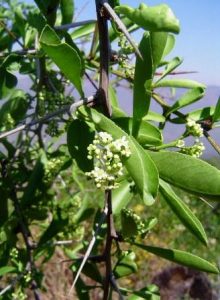
Maytenus heterophylla. Photo: Bart Wursten. Source: Flora of Zimbabwe
The Celastraceae is a family of trees and shrubs, many of which are climbing (Salacia) or twining (Hippocratea) in habit.
Distribution. The family is widespread, but concentrated in Sub- and tropical regions.
Diagnostic features. The leaves may be opposite or alternate even in a single genus as in Cassine. They are simple, often leathery, with or without small stipules. The flowers are small, greenish, regular, bisexual or unisexual and arranged usually in cymose inflorescences. The sepals and petals are inserted on or below the margin of a distinctive glandular fleshy disk. There are three to five sepals, free or united at the base, and three to five free petals (rarely none). The stamens alternate with and are equal in number to the petals and are inserted on the disk. The anthers have two locules and dehisce longitudinally (transverse dehiscence in Hippocratea). The ovary is superior. There is a single, very short style terminated by a capitate or two- to five-lobed stigma. The fruit is a loculicidal or indehiscent capsule, a samara, berry or drupe. The capsule of some species of Euonymus may possess spiny outgrowths. The seeds possess a large, straight embryo surrounded by fleshy endosperm and is often covered by a brightly coloured aril, which aids in dispersal by birds.
Classification. The chief genera are Maytenus (225 tropical species), Salacia (200 tropical species), Euonymus (176 species mostly from the Himalayas, China and Japan). Hippocratea (120 species, tropical South America, Mexico and southern USA). Cassine (40 species, South Africa, Madagascar, tropical Asia and the Pacific), Celastrus (30 subtropical and tropical species), Pachystima (five species, North America) and Gyminda (three species, Central America, Mexico and Florida).
Economic uses. The small khat tree, Catha edulis, is cultivated in the Middle East and Ethiopia for its leaves, used to make an infusion of tea (Arabian tea) or in the making of a honey wine (in Ethiopia). The seeds of Kokoona zeylanica (kokoon tree) are used as a source of oil in Ceylon. A number of species of Euonymus yield useful products including the spindle tree (Euonymus europaeus) whose fine-grained wood is used for turnery and figure carving and as a source of charcoal. The seeds of this species yield oil used in soap manufacture and a yellow dye for colouring butter. The heavy, durable, close-grained wood of the Japanese shrub Euonymus hians, is also used for turnery and for making printing blocks. Some species, such as Euonymus japonicus and Euonymus sieboldiana yield a rubber-like latex from the stems and roots. Extracts from Euonymus purpureus and Euonymus americanus are used in native medicines in North America. Species of other genera which yield medicinal extracts include Elaeodendron glaucaum, Maytenus boania, Maytenus ilicifolia and Maytenus senegalensis, and Hippocratea acapulcensis. Species of Celastrus, Euonymus, Elaeodendron, Pachystima and Maytenus are cultivated as ornamentals.
From Flowering Plants of the World -Consultant Editor V H Heywood.
Members of the Celastraceae occurring in Zimbabwe are:
Maytenus acuminata ES
Maytenus chasei E
Maytenus heterophylla
ssp. heterophylla NWCES
ssp. puberula W
Maytenus mossambicensis
var. mossambicensis ES
Maytenus oxycarpa S
Maytenus pubescens ES
Maytenus putterlickioides NWES
Maytenus senegalensis NWCES
Maytenus tenuispina S
Maytenus undata NWCES
Catha edulis NWCES
Pterocelastrus echinatus CES
Mystroxylon aethiopicum NWCES
Elaeodendron matabelicum NWCES
Elaeodendron capense E
Elaeodendron schlechterianum NS
Pseudocassine transvaalensis NWCES
Allocassine laurifolia E
Pleurostylia africana NCES
Hippocratea (see Tree Life No.200)
Salacia erecta E
Salacia kraussii S
Salacia leptoclada E
Update on Phytochemistry and Pharmacology of Maytenus sp.
Plants of the Maytenus genus (Celastraceae) have been the subjects of a significant amount of recent scientific research and chemical analysis. Studies have been performed on African, South American, and Asian species and have been inspired by their traditional medical uses.
Extracts of leaves and barks of different Maytenus species have been found to contain a wide array of terpene-bases compounds e.g. mayteine and derivatives. Many of these compounds have been found to have anticancer activity in the laboratory (in vitro) against various cancer and leukaemia cell cultures. Others have been found to raise the pH of gastric fluids in laboratory animals. These findings are consistent with the traditional uses of Maytenus sp. in South America to treat tumours and stomach ulcers.
In Tanzania, Maytenus senegalensis is used traditionally to treat malaria. A recent study found that extracts of this species were active against malaria parasites in vitro.
Further studies are required to determine whether the effects observed in the laboratory can be reproduced in vivo in man. Before this can be studied, the extracts and compounds have to be investigated to determine whether or not they are toxic in laboratory animals. However, it is possible that sp. may provide modern medicinal agents in the future.
-Douglas Ball.
BACK NUMBERS OF TREE LIFE.
Mr. Duncan Torrance is offering 5 years’ worth of Tree Life to any interested person. They may be of interest to a new member. They number from issue No.143 to No.202. Duncan’s address is – 1 Sareba, Glenside Drive, Strathaven. P 0 Avondale.
Sybil Duncanson likewise, has a pile of back issues to give away.
ANDY MACNAUGHTAN CHAIRMAN


